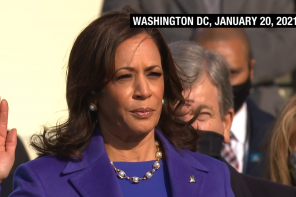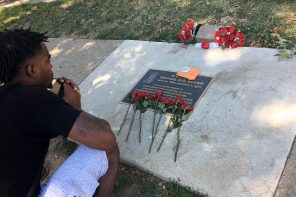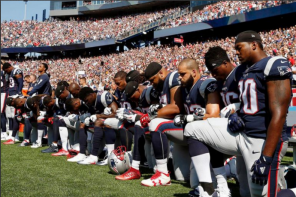The unabated string of murders of Black people at the hands of police over the past month is a heart-wrenching reminder that citizenship does not protect us from state-inflicted violence.
Nor does it protect us from the kind of social violence that Gabrielle Douglas endured during the Rio Olympics when she chose to stand at attention rather than placing her hand on her heart during the pledge of allegiance. More recently, Colin Kaepernick has continued his protest, but faces death threats, and the Los Angeles Lakers faced condemnation for their protest Tuesday evening—a sobering reminder that proper performance of civic ritual can be a matter of life and death for Black and Brown people.
In 2008, when jazz singer Rene Marie sang a unique arrangement of “The Star Spangled Banner,” with words from James Weldon Johnson’s “Lift Every Voice and Sing,” her performance was denounced by numerous elected officials, including the president. President Obama remarked, “If she was asked to sing the national anthem, she should have sung that,” Obama said. “‘Lift Every Voice and Sing’ is a beautiful song, but we only have one national anthem.”
Marie later responded by saying though the national anthem is sacred to others, it’s not sacred to her: “The guy, the dude who wrote it, he was a slave owner.”
For marginalized people to defy tradition, to walk with pride, and to speak in their own authorial voice is to commit the ultimate act of impiety. Nationalism and patriotism are not abstract principles expressing the highest ideals, they are part of American civil religion. And as a new generation of scholarship and activism argues, white supremacy is woven into the very fabric of that system of belief.
In 2015’s Stand your Ground: Black Bodies and the Justice of God, Kelly Brown Douglas tells the story of a 1923 Supreme Court case in which an Indian immigrant, Bhagat Singh Thind, petitioned for naturalized citizenship, contending that he was the descendant of a high caste Hindu, which meant he was Aryan and therefore white.
The majority opinion denied Thind’s claim, stating that:
The children of ‘English, French, Italian, Scandinavian, and European parentage quickly merge into the mass of our population and lose the distinctive hallmarks of their origin…On the other hand…children born in this country of Hindu parents would retain indefinitely clear evidence of their ancestry.
Thind was denied citizenship because he did not appear to be white. The case marked a seismic shift in American conceptions of the white body, Douglas explains, because Anglo-Saxon blood proved that it was able to “stand its ground against the threat of contamination.” The Thind case laid the groundwork for the white body as exceptional and therefore sacred.
Douglas contends that white bodies, which she describes as “castles,” carry their sacredness with them wherever they go. If we take Douglas’ theory to its conclusion, all civic space becomes part of the white American sacred.
American civil religion, seen this way, is predicated on the protection of the white body, property ownership, veneration of founding patriarchs and flag worship. It is a religion that values national sovereignty above all else, and consumes non-white bodies that, like Thind’s, “retain indefinitely clear evidence of their ancestry.” All who do not worship the white American deity, and who transgress white American sacred space are met with spiritual, social, or physical violence. Under such circumstances, Black and Brown bodies are always perceived as dangerous.
As Benjamin Zeller explains, here in RD, Kaepernick is seen as disrespecting not just the flag, but the “nation’s self-worship.” And Joseph Winters argues that protests like Kaepernick’s direct attention to the gap between American ideals and its present reality without questioning the underlying “sacred quality of these notions.” Bodily refusals like Kaepernick’s, Winters argues, are believed to “‘contaminate’ the sacred space, and time, of Sunday football and the nation-state.”
American civil religion, with white supremacy woven through its history and ideals, depends on symbols and totems, and the American flag is one of the most potent. And yes, American civil religion thematizes Black bodies as an imagined source of disorder.
However, I would like to point out that Black people, Black athletes and Black soldiers have always been both disposable and indispensable parts of (white) American civil religion. They have always been commodities, sources of entertainment, and sources of protection while paradoxically being impoverished, uninteresting and threatening. When Black athletes like Gabrielle Douglas fail to be model Olympians and model players, they become unexceptional in the public eye—even treasonous.
In choosing not to practice the rituals of American civil religion, protesters like Kaepernick profane the (white) American sacred and like Thind, are rejected.
For Black and Brown Americans, the meaning of citizenship and the likelihood of survival are always dependent upon proper piety. After all, defying tradition and profaning the sacred may just be “clear evidence of their ancestry.”





